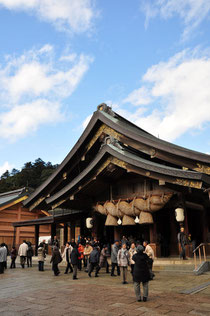Izumo Taisha

One of the most ancient and important Shinto shrines in all of Japan, Izumo Taisha has no known date of establishment. Rather, according to legend, it was a gift of the Sun Goddess Amaterasu, ancestor of all Japan’s emperors, to the god Okuninushi-no-Mikoto, who created the nation of Japan and offered it as a gift to the sun goddess’ grandson. Dedicated to Okuninushi, who is also considered the god of marriage, the shrine is second in importance only to Ise Jingu in Mie Prefecture, where Amaterasu herself is enshrined.
Izumo Taisha defines the forms of taisha-zukuri, or ‘shrine-style construction’, notably identified by chigi, or scissor-shaped fins, at the front and back of the structure’s roof. While the current structure is low to the ground, according to the two oldest chronicles of Japan, the Kojiki and the Nihon Shoki, Izumo Taisha was once 50 m tall, making it higher than Todaiji Temple in Nara, which, at 46 meters, remains the largest wooden structure in the world. Before Izumo Taisha stands the Kaguraden, a hall built for traditional rituals in 1776. Below its roof hangs a 13.5 meter-long, 5-ton shimenawa (sacred straw rope), the largest of its kind in Japan.
According to Shinto myth, the Japanese islands were once controlled from Izumo. Excavations from the area have found a greater concentration of bronze-age relics here than anywhere else in Japan. The small museum on the grounds (150 yen) features a Masamune dated from 1334, swords given by 4th Tokugawa shogun, and a sword from Toyotomi Hideyoshi, the warlord who unified Japan to pave the way for Tokugawa dominance, presented to the shrine by his son Hideyori.
In the old Japanese calendar, the tenth month was known as Kannazuki, or ‘the month without gods’, because it was at this time that all of Japan’s eight million gods congregated at Izumo Taisha. In Izumo alone, the month was known as Kamiarizuki, or ‘the month when the gods are present’.
To this day, Izumo resists the public decline and official disengagement from Japanese traditional religion. While most Japanese shrines have become museum pieces, silent and empty, shrines in both Izumo and Matsue are full of pews, with bells and flutes to be heard as worshippers gather early on a Saturday. Hordes of ojiichan and obaachan (gandpas and grandmas) regularly descend upon Izumo Taisha by the busload.
Izumo Taisha is roughly one hour from Matsue by train (790 yen from Matsue Shinjiko Onsen Station). At present, the shine is still undergoing its first full reconstruction since 1744, but much of the concealing siding was removed in March, with the final touches to be completed in 2014.











